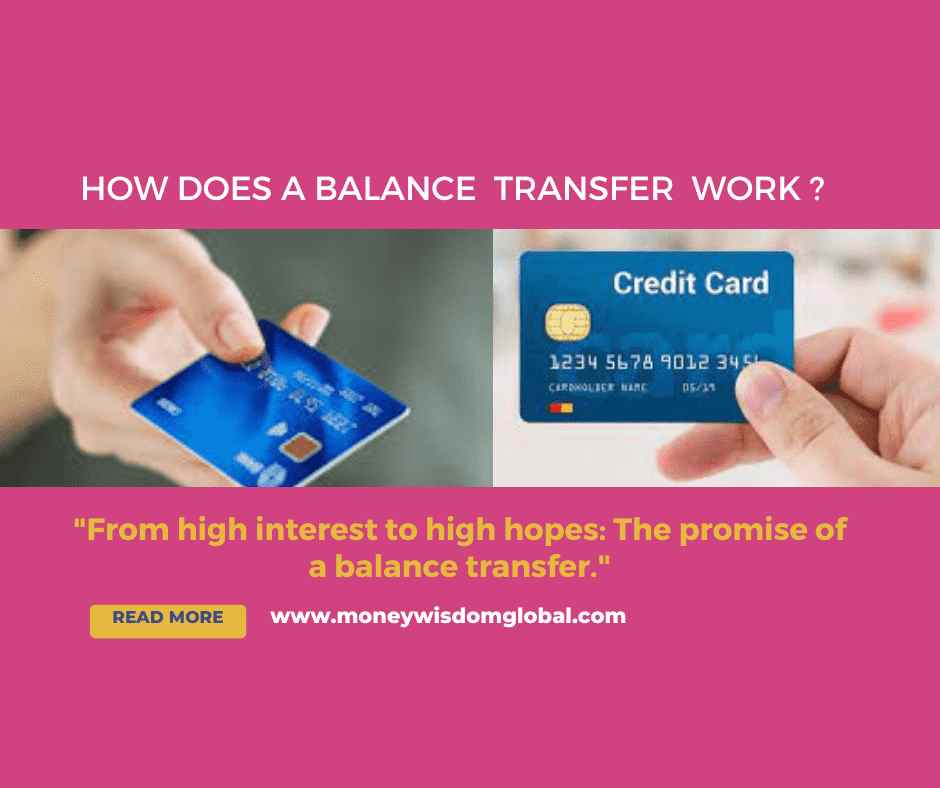
Introduction
The weight of credit card debt can often cast a shadow on our hopes for financial success in the intricate web of personal finance.
A ray of hope materializes in the shape of a balance transfer, a financial move that offers relief from the burden of high-interest rates and mounting debt. A balance transfer offers a route to move from the world of high-interest debt to the refuge of financial comfort, akin to a bridge connecting distant coasts.
Understanding Balance Transfers: A Financial Reshuffling
A balance transfer is a financial maneuver that involves moving existing credit card debt from one card to another, typically to secure a lower interest rate. This process allows you to transfer the debt from a high-interest credit card to one that offers an introductory period with reduced or even zero interest.
Benefits of Balance Transfers
Let’s explore the advantages that balance transfers offer those looking for liberty in their finances.
Lower Interest Rates: A Respite from High Costs
One of the most compelling reasons to explore balance transfers is the prospect of significantly lower interest rates. Many balance transfer offers come with introductory periods during which interest rates are reduced or even eliminated. This reduction in interest allows you to allocate a larger portion of your payments towards reducing the principal debt, effectively accelerating your journey to becoming debt-free.
Debt Consolidation: Streamlining Your Finances
Juggling multiple credit card balances can be mentally and logistically challenging. A balance transfer offers the opportunity to consolidate various credit card debts onto a single card. This consolidation simplifies your financial landscape, transforming a web of payments into a single, manageable monthly commitment.
Savings on Interest: A Financial Win-Win
Reducing interest rates isn’t merely a short-term benefit; it has a lasting impact on your financial health. By paying less in interest, you save money that can be channeled towards other financial goals, such as building an emergency fund, investing, or saving for larger purchases.
Faster Debt Repayment: A Boost to Financial Progress
With the burden of high interest lifted, your payments make a more significant dent in your debt’s principal balance. This accelerated reduction can trim months or even years off the time it takes to repay your debt, enabling you to achieve financial freedom sooner.
Simplified Payments: An Organized Approach
Managing multiple credit card payments can be overwhelming. By consolidating your debt through a balance transfer, you streamline your payment process, making it easier to track progress and manage your financial obligations.
Improved Credit Score: A Positive Impact
Consistently managing your debt through a balance transfer, making on-time payments, and reducing credit card balances can have a positive impact on your credit score. Lower credit card utilization and a history of responsible repayment contribute to an improved credit profile.
Finding the Right Balance Transfer Offer
Let’s set out on a quest to discover the critical components that make up the ideal balance transfer offer, which will help us decide which offer best suits our goals.
- Introductory Period Length: The cornerstone of a balance transfer offer lies in its introductory period length. This is the duration during which the lower interest rate applies to the transferred balance. Seek offers with extended introductory periods, as they provide a more substantial window of opportunity to repay your debt without incurring high-interest charges.
- Interest Rate after the Introductory Period: While the allure of low or zero interest during the introductory period is undeniable, it’s equally important to consider the interest rate that will apply once this period concludes. Opt for offers with competitive post-introductory rates to ensure you’re well-prepared for the future.
- Transfer Fees: Before committing to a balance transfer offer, evaluate the associated fees. Some offers come with a transfer fee, typically a percentage of the transferred balance. While these fees may impact the immediate benefit, consider the overall savings you’ll achieve through lower interest rates.
- Credit Limit and Approval: Balance transfer offers are contingent on your creditworthiness. Research offers that match your credit profile, increasing the likelihood of approval. Ensure that the credit limit on the new card accommodates the transferred balance while leaving room for potential future expenses.
- Credit Card Issuer: Choose balance transfer offers from reputable credit card issuers. Established institutions often provide transparent terms, excellent customer service, and a reliable platform for managing your debt.
- Balance Transfer Compatibility: Consider whether the balance transfer offer aligns with your financial goals. Assess the offered credit limit, introductory period length, and any associated benefits to determine if they fulfill your specific requirements.
- Additional Card Features: Some balance transfer cards offer additional features, such as rewards programs, cashback incentives, or travel benefits. Evaluate whether these features align with your lifestyle and financial preferences.
- Credit Score Impact: Keep in mind that the process of applying for a new credit card, even for a balance transfer, may have a slight impact on your credit score. However, responsible credit management can mitigate any potential negative effects.
How Balance Transfers Work: A Step-by-Step Breakdown
We’ll walk you through the process of carrying out a successful balance transfer so you can realize your financial goals.
- Assess Your Existing Debt: Begin by taking a comprehensive inventory of your existing credit card debt. Note the balances, interest rates, and payment due dates for each card. This assessment forms the foundation upon which your balance transfer strategy will be built.
- Research Balance Transfer Offers: Survey the landscape of balance transfer offers available to you. Compare introductory period lengths, post-introductory interest rates, transfer fees, and credit limits. Seek offers that align with your financial goals and creditworthiness.
- Choose the Right Card: Select a balance transfer card that best suits your needs. Ensure that the introductory period provides sufficient time for debt repayment and that the post-introductory interest rate is competitive.
- Apply for the New Card: Submit your application for the chosen balance transfer card. This process involves sharing personal and financial information. Be prepared to provide details about your existing credit card debt for the transfer.
- Await Approval: Once you’ve applied, await the issuer’s decision. Approval is typically based on your creditworthiness and financial standing. Be patient during this phase, as it’s an essential step in the process.
- Review the Terms: Upon approval, carefully review the terms of the new card, particularly those related to the balance transfer offer. Understand the introductory period, post-introductory rates, transfer fees, and any other relevant information.
- Initiate the Balance Transfer: Once you have a clear understanding of the terms, initiate the balance transfer through the new card’s issuer. Provide the necessary information about your existing credit card accounts, including account numbers and balances to be transferred.
- Monitor the Transfer: Keep a close watch as the transfer takes place. Confirm that the transferred balances align with your records and that the process is executed smoothly.
- Focus on Debt Repayment: As the transferred balances settle into their new home, redirect your focus toward debt repayment. Utilize the interest-free or low-interest introductory period to make substantial progress in reducing your debt.
- Stay On Track: Adhere to your debt repayment plan and make payments on time. This disciplined approach ensures that you maximize the benefits of the balance transfer and set yourself on a path to financial freedom.
- Avoid New Charges: Refrain from using the new card for new purchases, especially if they come with different interest rates. Your primary objective during this phase is to pay off the transferred balance.
Potential Mistakes
You can run into difficulties when transferring balances. Equip yourself with the knowledge required to successfully traverse them.
- Missed Payments: One of the primary pitfalls to avoid is missing payments. Even during the interest-free or low-interest introductory period, failing to make payments on time can lead to the loss of the promotional rate. Set up reminders, automate payments, or adopt any strategy that ensures timely payments.
- New Purchases: While you’re focusing on repaying the transferred balance, be cautious about making new purchases on the balance transfer card. Many cards have different interest rates for balance transfers and new purchases. These new purchases might accrue interest from the moment of purchase, diminishing the benefits of the transfer.
- Deferred Interest: Some balance transfer offers include deferred interest, meaning that if you don’t repay the full transferred balance within the introductory period, you’ll be retroactively charged interest on the original balance. Understand the terms thoroughly to avoid falling into this trap.
- Post-Introductory Rates: Be aware that the introductory period is finite, and that the interest rate will increase once it ends. Factor this change into your debt repayment plan and ensure that you’re prepared for the transition.
- Credit Score Impact: While balance transfers can ultimately contribute to improved credit scores through responsible debt management, the initial application might have a minor impact. Be aware of this trade-off and prioritize responsible financial behavior to mitigate any temporary effects.
- Transfer Fees: While the allure of lower interest rates is undeniable, some balance transfer offers come with transfer fees. Consider whether the potential interest savings outweigh the upfront cost of the transfer.
- Overusing Credit: After successfully transferring a balance, you might be tempted to use the freed-up credit on your old card. Resist this urge, as it could lead to increased debt and undermine the progress you’ve made.
Alternatives to Balance Transfers: Exploring Options
It’s crucial to look into a wide range of options that fit your objectives and situation as you travel the route to relief from debt and financial freedom.
- Debt Snowball or Debt Avalanche: The debt snowball and debt avalanche methods involve prioritizing and paying off debts strategically. With the snowball method, you focus on paying off the smallest debt first, gaining momentum as you tackle larger debts. The avalanche method targets high-interest debts first, minimizing overall interest costs. Choose the approach that resonates with your financial personality and aligns with your debt portfolio.
- Personal Loans: Personal loans provide another avenue for debt consolidation. Unlike balance transfers, personal loans are not tied to credit card accounts. They allow you to consolidate various debts into a single loan with a fixed interest rate and a structured repayment plan. Personal loans can be particularly useful if you have multiple types of debt beyond credit cards.
- Seek Professional Advice: Enlisting the services of a certified financial advisor can provide personalized guidance tailored to your specific financial situation. Advisors can help you develop a comprehensive debt management plan, evaluate the benefits of different approaches, and provide insights into optimizing your financial strategies.
- Credit Counseling and Debt Management Programs: Credit counseling agencies offer services to help individuals manage debt. They can negotiate with creditors for lower interest rates, fees, and monthly payments. While this approach doesn’t involve a balance transfer, it can help you navigate debt more effectively with the assistance of professionals.
- Lifestyle and Spending Changes: Addressing the root causes of debt involves adopting sustainable changes to your lifestyle and spending habits. Creating a realistic budget, curbing unnecessary expenses, and boosting your savings can all contribute to reducing the need for credit cards and loans.







